Abstract
To determine whether intravenous infusion of individual amino acids stimulated gastric acid secretion in man, graded doses of phenylalanine, tryptophan, glycine, alanine, histidine, and NaCl control were infused on separate days in nine healthy subjects. Intravenous infusion of phenylalanine and tryptophan significantly stimulated gastric acid secretion to 50 and 52%, respectively, of the acid secretory response to intragastric peptone. Intravenous alanine and histidine were without effect, whereas glycine produced a slight response. Serum gastrin concentrations did not significantly change during intravenous amino acid infusion, except in response to 0.1 M phenylalanine. However, the increase in serum gastrin occurred 2 h after acid secretion had significantly increased in response to the 0.025 M phenylalanine infusion. Plasma amino acid concentrations were measured during intravenous amino acid infusion and in response to a steak meal in five of the subjects. At a time when acid secretion was significantly increased during intravenous infusion of phenylalanine and tryptophan, plasma amino acids were similar to, or less than, that observed after the steak meal, suggesting that circulating levels of these three amino acids have a physiologic effect on gastric secretion in man. Intravenous infusion of a combination of graded doses of phenylalanine plus a continuous infusion of 0.01 M tryptophan shifted the dose-response curve to the left and resulted in a significantly greater response than to either amino acid alone. In five subjects with parietal cell vagotomy, intravenous phenylalanine and tryptophan stimulated acid secretion, whereas histidine was without effect, similar to normal subjects. These studies indicate that intravenous infusion of small amounts of phenylalanine (0.025 M, 3.1 mmol/h) and tryptophan (0.01 M, 1.25 mmol/h) stimulated gastric acid secretion at plasma concentrations similar to those observed after a steak meal, suggesting a physiologic role for circulating levels of these amino acids on gastric acid secretion. Because acid secretion increased at a time when serum gastrin was unchanged and since there was no correlation between changes in serum gastrin and acid secretion, the responses to phenylalanine and tryptophan are probably mediated by a nongastrin-related mechanism(s). Since both phenylalanine and tryptophan stimulated secretion in vagotomized subjects, the response is vagally independent. These observations suggest that circulating levels of these two amino acids have either a direct or indirect effect on or near the human parietal cell.
Full text
PDF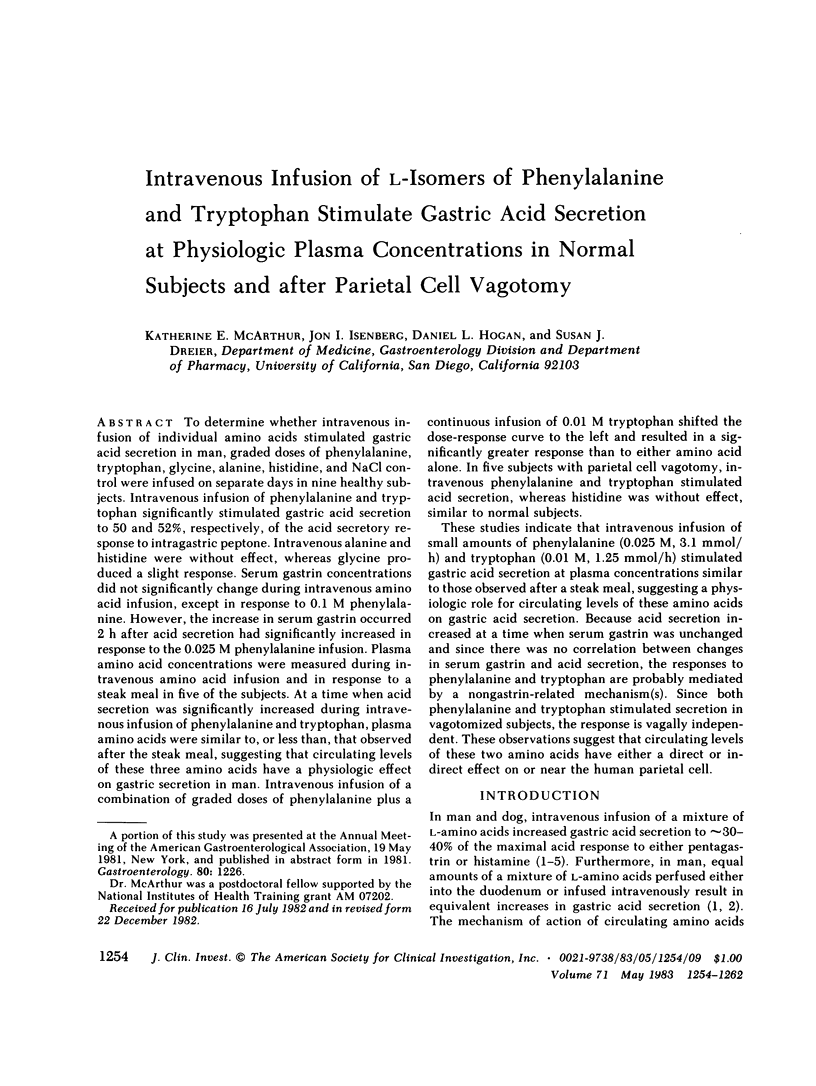
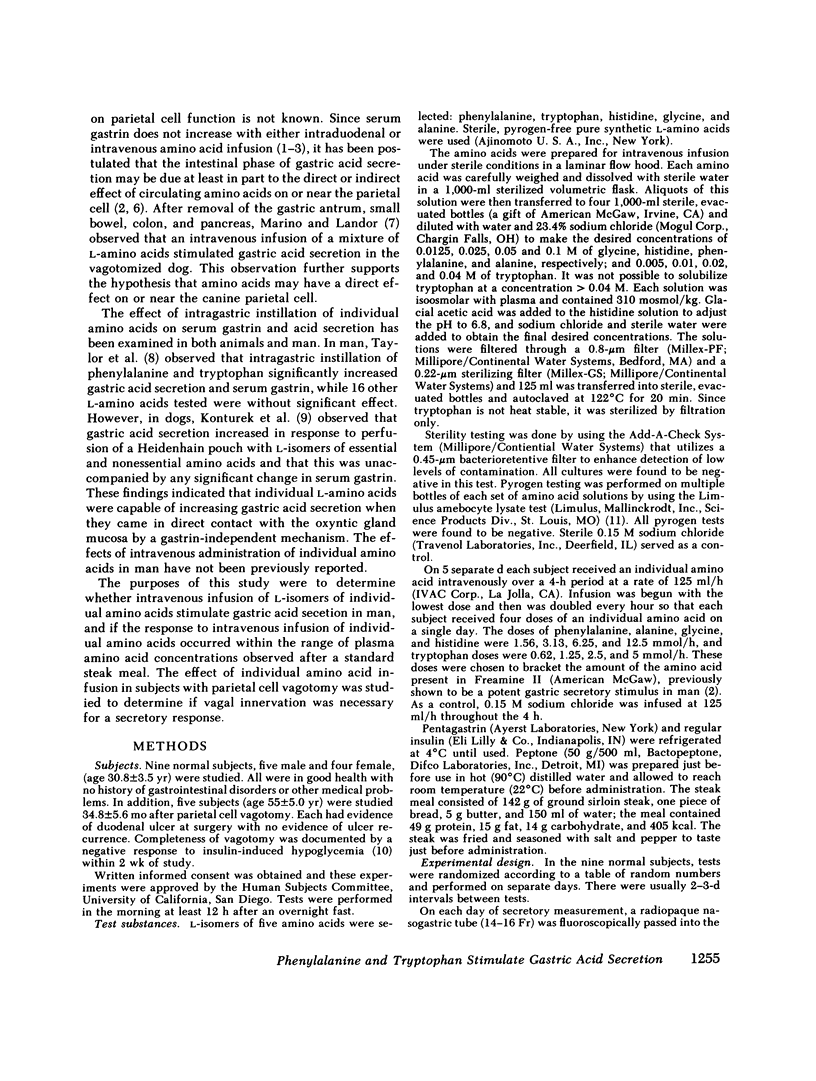
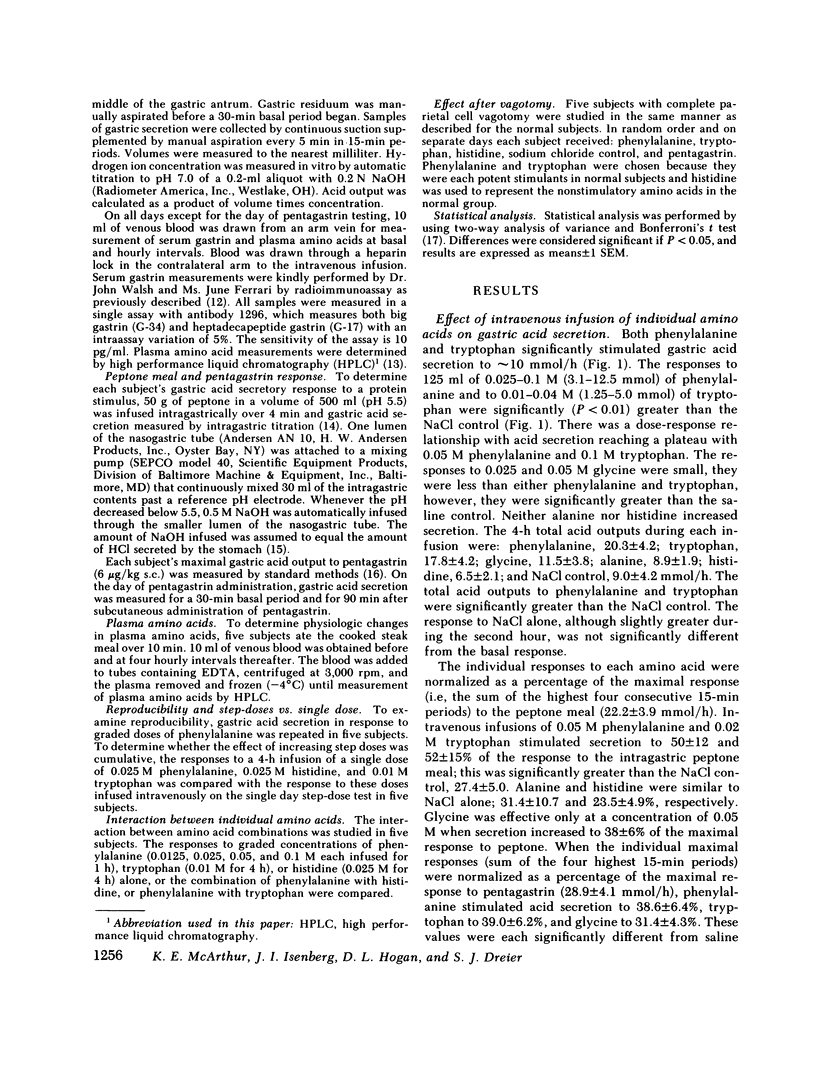
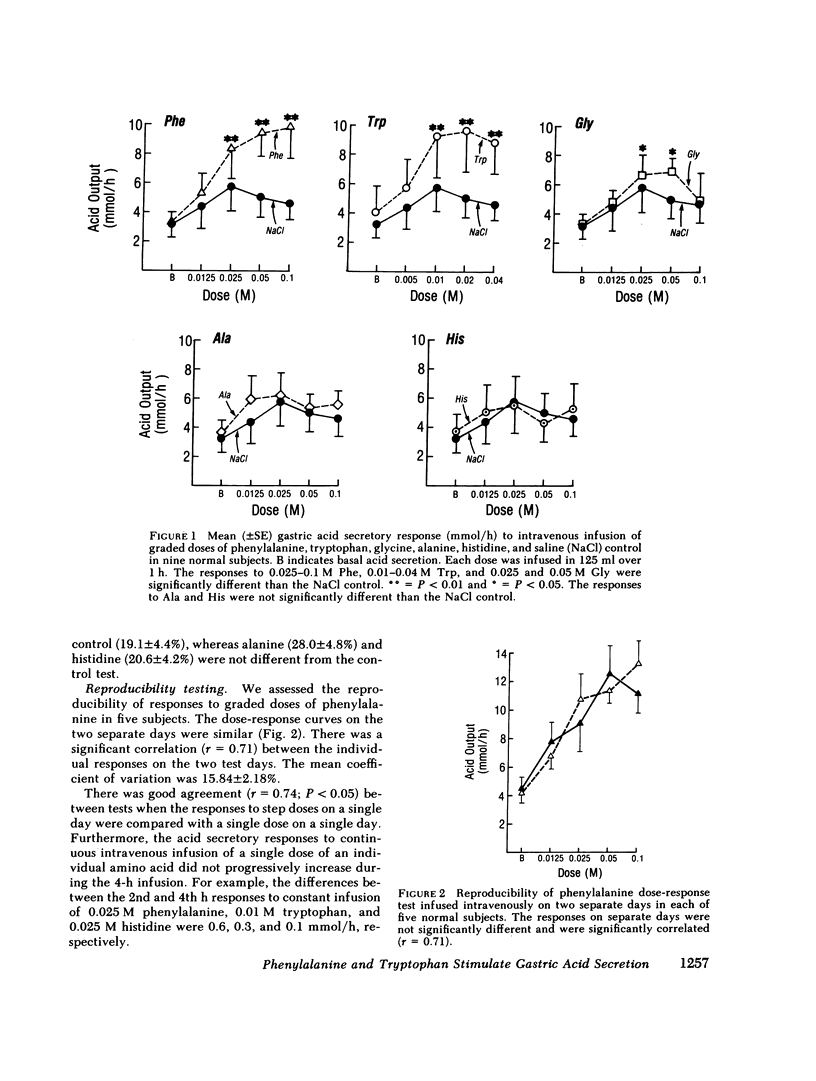
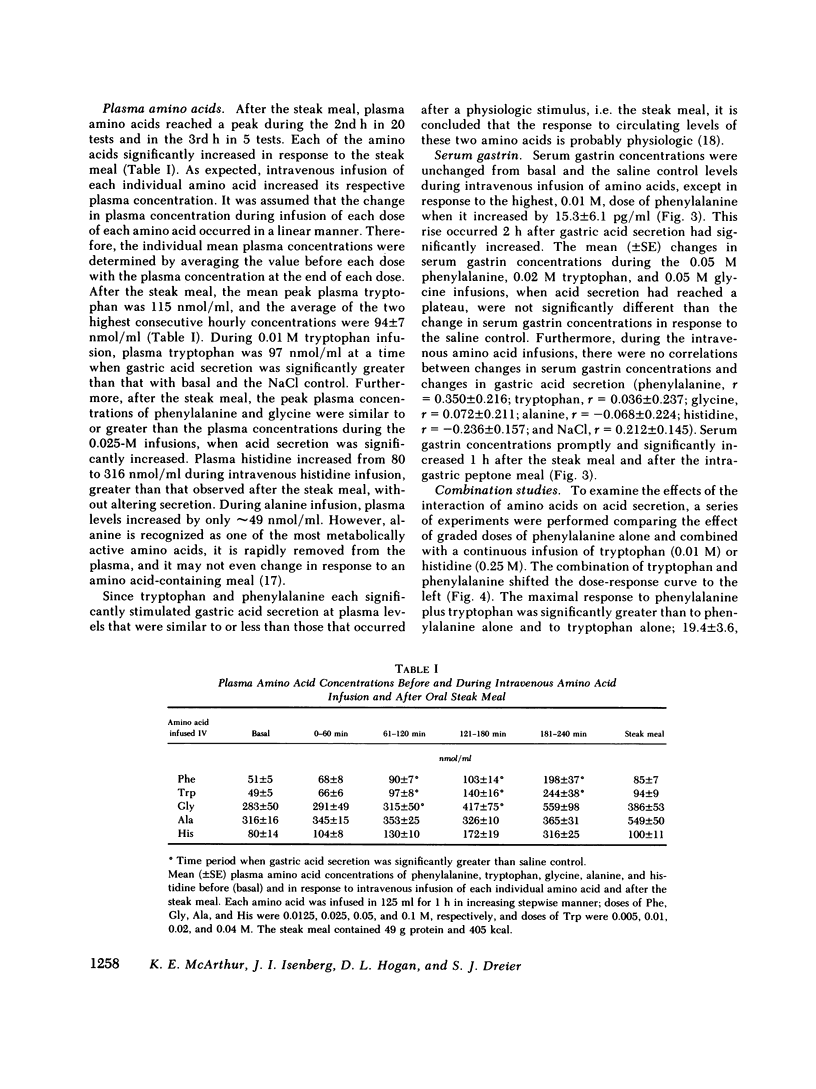
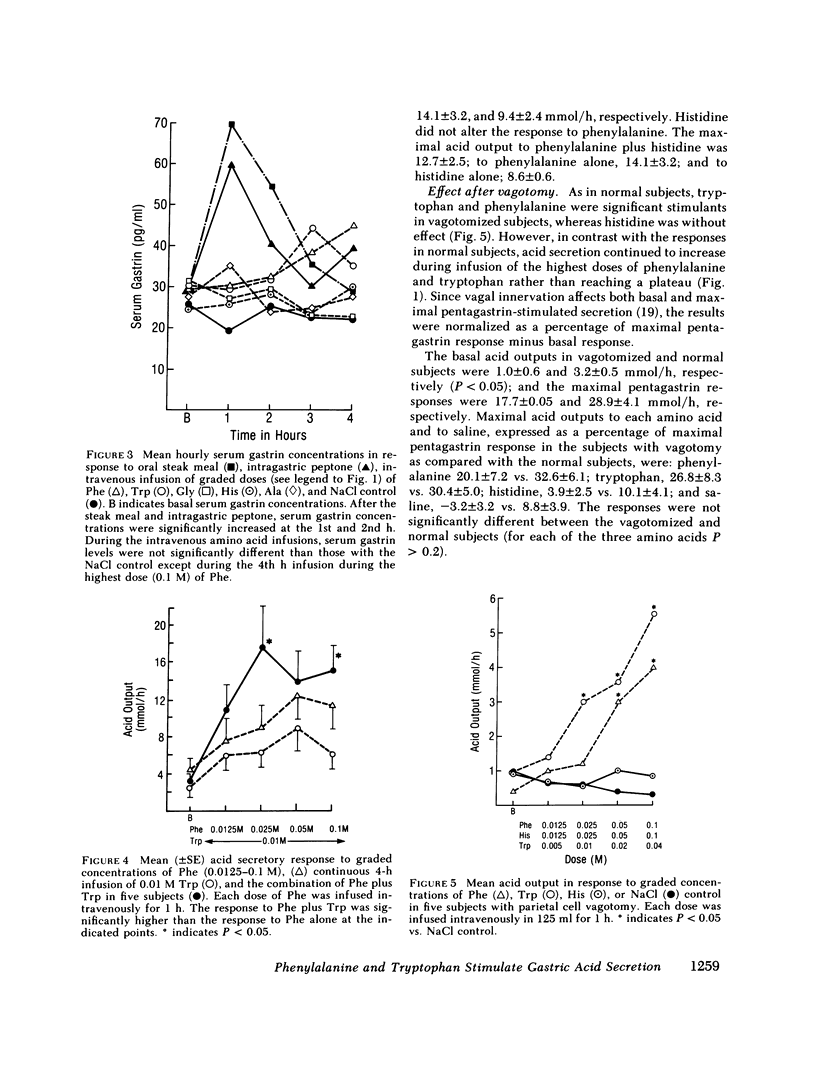
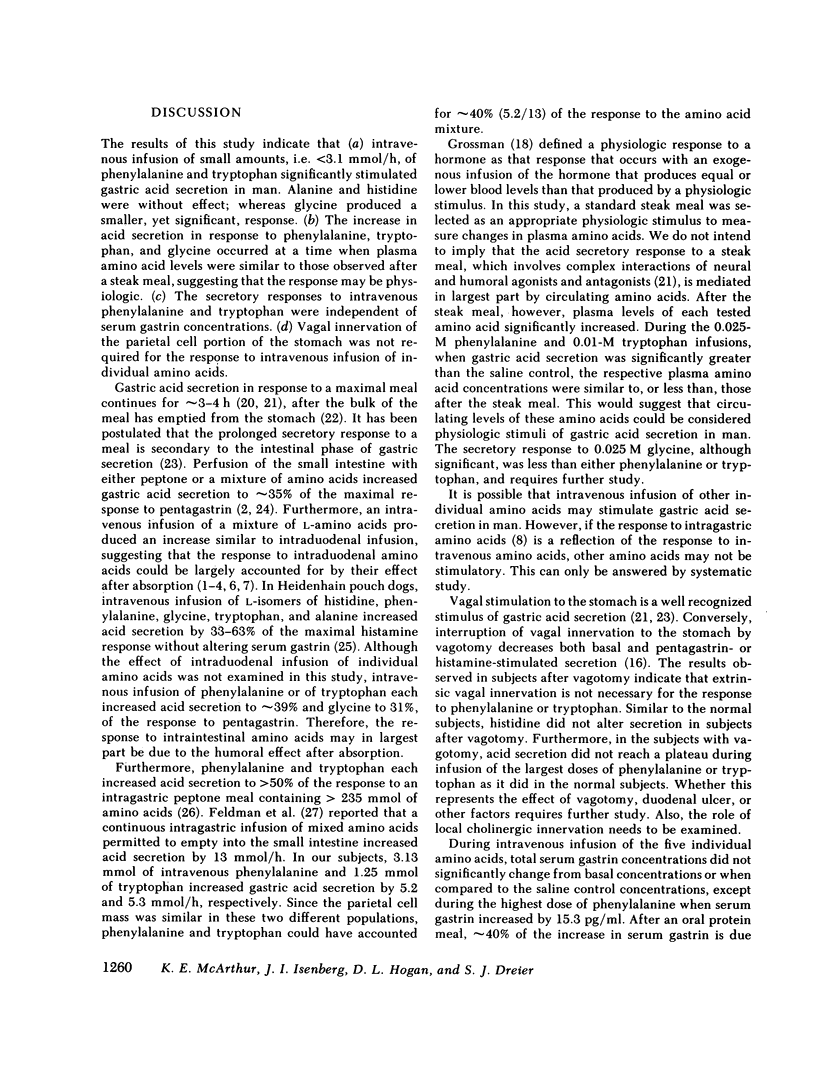
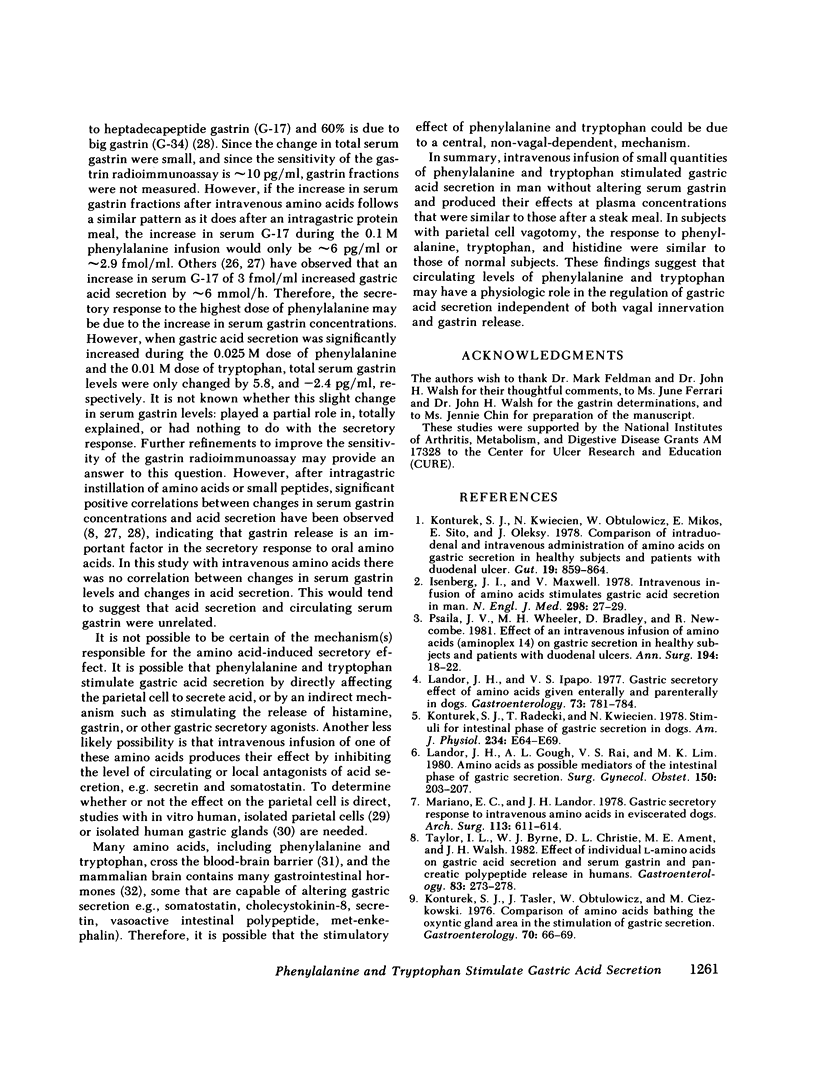
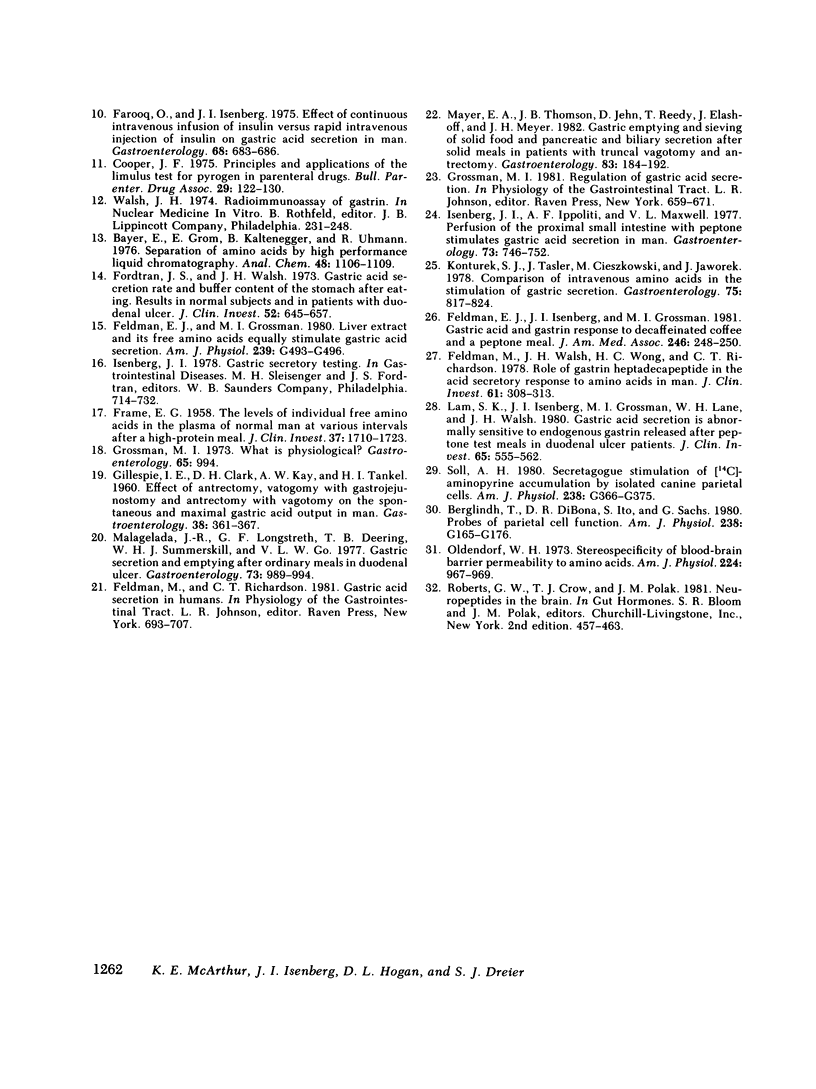
Selected References
These references are in PubMed. This may not be the complete list of references from this article.
- Bayer E., Grom E., Kalteneger B., Uhmann R. Separation of amino acids by high performance liquid chromatography. Anal Chem. 1976 Jul;48(8):1106–1109. doi: 10.1021/ac50002a010. [DOI] [PubMed] [Google Scholar]
- Berglindh T., Dibona D. R., Ito S., Sachs G. Probes of parietal cell function. Am J Physiol. 1980 Mar;238(3):G165–G176. doi: 10.1152/ajpgi.1980.238.3.G165. [DOI] [PubMed] [Google Scholar]
- Cooper J. F. Principles and applications of the limulus test for pyrogen in parenteral drugs. Bull Parenter Drug Assoc. 1975 May-Jun;29(3):122–130. [PubMed] [Google Scholar]
- FRAME E. G. The levels of individual free amino acids in the plasma of normal man at various intervals after a high-protein meal. J Clin Invest. 1958 Dec;37(12):1710–1723. doi: 10.1172/JCI103763. [DOI] [PMC free article] [PubMed] [Google Scholar]
- Farooq O., Isenberg J. I. Effect of continuous intravenous infusion of insulin versus rapid intravenous injection of insulin on gastric acid secretion in man. Gastroenterology. 1975 Apr;68(4 Pt 1):683–686. [PubMed] [Google Scholar]
- Feldman E. J., Grossman M. I. Liver extract and its free amino acids equally stimulate gastric acid secretion. Am J Physiol. 1980 Dec;239(6):G493–G496. doi: 10.1152/ajpgi.1980.239.6.G493. [DOI] [PubMed] [Google Scholar]
- Feldman E. J., Isenberg J. I., Grossman M. I. Gastric acid and gastrin response to decaffeinated coffee and a peptone meal. JAMA. 1981 Jul 17;246(3):248–250. [PubMed] [Google Scholar]
- Feldman M., Walsh J. H., Wong H. C., Richardson C. T. Role of gastrin heptadecapeptide in the acid secretory response to amino acids in man. J Clin Invest. 1978 Feb;61(2):308–313. doi: 10.1172/JCI108940. [DOI] [PMC free article] [PubMed] [Google Scholar]
- Fordtran J. S., Walsh J. H. Gastric acid secretion rate and buffer content of the stomach after eating. Results in normal subjects and in patients with duodenal ulcer. J Clin Invest. 1973 Mar;52(3):645–657. doi: 10.1172/JCI107226. [DOI] [PMC free article] [PubMed] [Google Scholar]
- GILLESPIE I. E., CLARK D. H., KAY A. W., TANKEL H. I. Effect of antrectomy, vagotomy with gastrojejunostomy, and antrectomy with vagotomy on the spontaneous and maximal gastric acid output in man. Gastroenterology. 1960 Mar;38:361–367. [PubMed] [Google Scholar]
- Grossman M. I. Letters: What is physiological? Gastroenterology. 1973 Dec;65(6):994–994. [PubMed] [Google Scholar]
- Isenberg J. I., Ippoliti A. F., Maxwell V. L. Perfusion of the proximal small intestine with peptone stimulates gastric acid secretion in man. Gastroenterology. 1977 Oct;73(4 Pt 1):746–752. [PubMed] [Google Scholar]
- Isenberg J. I., Maxwell V. Intravenous infusion of amino acids stimulates gastric acid secretion in man. N Engl J Med. 1978 Jan 5;298(1):27–29. doi: 10.1056/NEJM197801052980106. [DOI] [PubMed] [Google Scholar]
- Konturek S. J., Kwiecień N., Obtułowicz W., Mikoś E., Sito E., Oleksy J. Comparison of intraduodenal and intravenous administration of amino acids on gastric secretion in healthy subjects and patients with duodenal ulcer. Gut. 1978 Oct;19(10):859–864. doi: 10.1136/gut.19.10.859. [DOI] [PMC free article] [PubMed] [Google Scholar]
- Konturek S. J., Radecki T., Kwiecień N. Stimuli for intestinal phase of gastric secretion in dogs. Am J Physiol. 1978 Jan;234(1):E64–E69. doi: 10.1152/ajpendo.1978.234.1.E64. [DOI] [PubMed] [Google Scholar]
- Konturek S. J., Tasler J., Cieszkowski M., Jaworek J. Comparison of intravenous amino acids in the stimulation of gastric secretion. Gastroenterology. 1978 Nov;75(5):817–824. [PubMed] [Google Scholar]
- Konturek S. J., Tasler J., Obtulowicz W., Cieszkowski M. Comparison of amino acids bathing the oxyntic gland area in the stimulation of gastric secretion. Gastroenterology. 1976 Jan;70(1):66–69. [PubMed] [Google Scholar]
- Lam S. K., Isenberg J. I., Grossman M. I., Lane W. H., Walsh J. H. Gastric acid secretion is abnormally sensitive to endogenous gastrin released after peptone test meals in duodenal ulcer patients. J Clin Invest. 1980 Feb;65(2):555–562. doi: 10.1172/JCI109699. [DOI] [PMC free article] [PubMed] [Google Scholar]
- Landor J. H., Gough A. L., Rai V. S., Lim M. K. Amino acids as possible mediators of the intestinal phase of gastric secretion. Surg Gynecol Obstet. 1980 Feb;150(2):203–207. [PubMed] [Google Scholar]
- Landor J. H., Ipapo V. S. Gastric secretory effect of amino acids given enterally and parenterally in dogs. Gastroenterology. 1977 Oct;73(4 Pt 1):781–784. [PubMed] [Google Scholar]
- Malagelada J. R., Longstreth G. F., Deering T. B., Summerskill W. H., Go V. L. Gastric secretion and emptying after ordinary meals in duodenal ulcer. Gastroenterology. 1977 Nov;73(5):989–994. [PubMed] [Google Scholar]
- Mariano E. C., Landor J. H. Gastric secretory response to intravenous amino acids in eviscerated dogs. Arch Surg. 1978 May;113(5):611–614. doi: 10.1001/archsurg.1978.01370170073014. [DOI] [PubMed] [Google Scholar]
- Mayer E. A., Thompson J. B., Jehn D., Reedy T., Elashoff J., Meyer J. H. Gastric emptying and sieving of solid food and pancreatic and biliary secretion after solid meals in patients with truncal vagotomy and antrectomy. Gastroenterology. 1982 Jul;83(1 Pt 2):184–192. [PubMed] [Google Scholar]
- Oldendorf W. H. Stereospecificity of blood-brain barrier permeability to amino acids. Am J Physiol. 1973 Apr;224(4):967–969. doi: 10.1152/ajplegacy.1973.224.4.967. [DOI] [PubMed] [Google Scholar]
- Psaila J. V., Wheeler M. H., Bradley D., Newcombe R. Effect of an intravenous infusion of aminoacids (Aminoplex 14) on gastric secretion in healthy subjects and patients with duodenal ulcers. Ann Surg. 1981 Jul;194(1):18–22. doi: 10.1097/00000658-198107000-00004. [DOI] [PMC free article] [PubMed] [Google Scholar]
- Soll A. H. Secretagogue stimulation of [14C]aminopyrine accumulation by isolated canine parietal cells. Am J Physiol. 1980 Apr;238(4):G366–G375. doi: 10.1152/ajpgi.1980.238.4.G366. [DOI] [PubMed] [Google Scholar]
- Taylor I. L., Byrne W. J., Christie D. L., Ament M. E., Walsh J. H. Effect of individual l-amino acids on gastric acid secretion and serum gastrin and pancreatic polypeptide release in humans. Gastroenterology. 1982 Jul;83(1 Pt 2):273–278. [PubMed] [Google Scholar]


